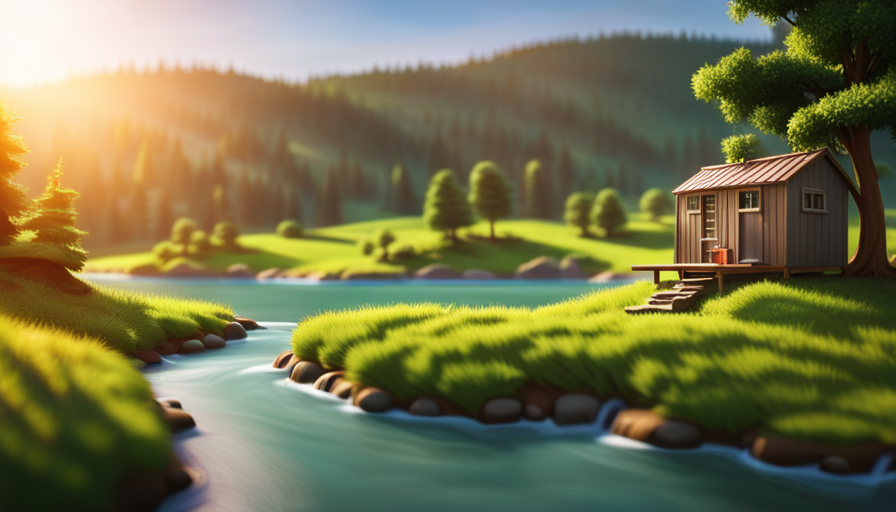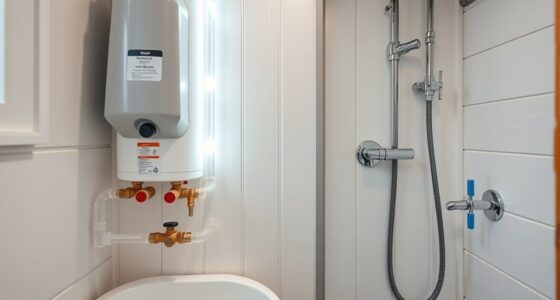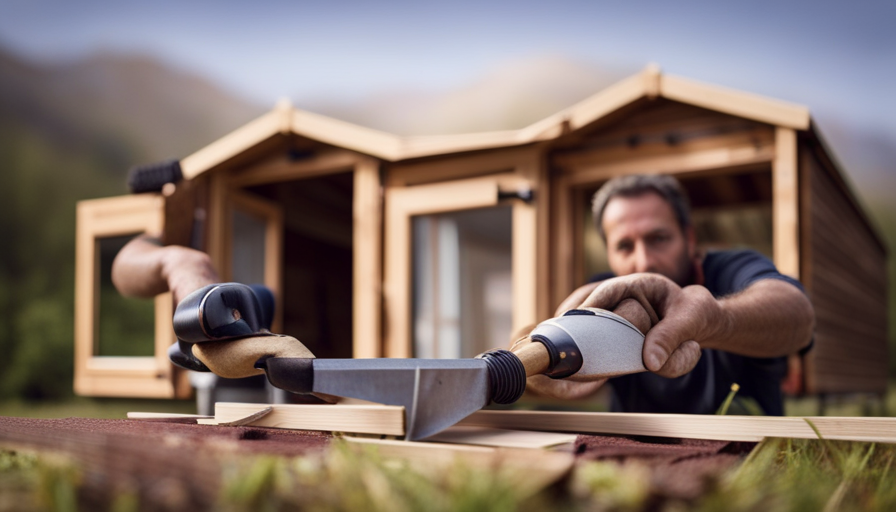The saying goes, ‘Good things come in small packages,’ and this rings particularly true when looking for the perfect piece of land for your tiny home. With the growing popularity of tiny houses, it is essential to approach the search for the ideal plot with careful consideration and knowledge.
In this article, I will guide you through the steps to finding land for your tiny house, ensuring that you make the right choice for your needs and preferences. From researching zoning laws and regulations to connecting with real estate agents and landowners, I will provide you with valuable insights and resources.
Additionally, I will share tips on utilizing online land listing platforms, attending land auctions, and exploring rural areas and small towns. By consulting with legal and financial professionals and joining tiny house communities, you will be well-equipped to find the perfect plot of land for your tiny house.
So let’s get started on this exciting journey towards finding your own little piece of paradise.
Key Takeaways
- Determine your needs and preferences for your tiny house.
- Research zoning laws and regulations to ensure compliance.
- Explore alternative options like tiny house communities or RV parks.
- Connect with real estate agents and landowners in your desired area.
Determine Your Needs and Preferences
Think about what you truly want and need in a place to call home for your tiny house, so you can create a space that brings you joy and fulfillment. When searching for land for your tiny house, it’s essential to consider factors such as land availability and budget planning.
Land availability refers to the availability of suitable land for your tiny house. You need to research and find out if there are any restrictions or limitations on building a tiny house on the land you’re considering. Additionally, consider the location and proximity to amenities such as grocery stores, schools, and hospitals.
Budget planning is another crucial aspect to consider. Determine how much you’re willing to spend on purchasing land and factor in any additional costs such as utilities connection fees or site preparation. It’s important to be realistic and ensure that the cost of the land aligns with your overall budget for your tiny house project.
Once you have determined your needs and preferences and have a budget in mind, you can start researching zoning laws and regulations to ensure that your tiny house will comply with any local requirements. This will help you find the perfect location for your tiny house and ensure a smooth process in the future.
Research Zoning Laws and Regulations
When researching zoning laws and regulations for my tiny house, it’s important to understand the local ordinances in my desired location.
By familiarizing myself with these regulations, I can ensure that my tiny house will be in compliance and avoid any legal issues.
Additionally, it’s worth exploring alternative options such as tiny house communities or RV parks, as these may have more lenient zoning requirements and provide a supportive community for tiny house living.
Understand local zoning ordinances
Before you start searching for land for your tiny house, it’s crucial to understand the local zoning ordinances that could affect your dream home. Researching local regulations and consulting with experts will give you a clear understanding of what is allowed and what is not in your area. To help you get started, here is a table outlining some common zoning restrictions you may encounter:
| Zoning Ordinance | Restrictions |
|---|---|
| Residential | Minimum square footage requirements, setback regulations, height limits |
| Agricultural | Limitations on accessory dwellings, farming activities |
| Historic District | Preservation guidelines, architectural restrictions |
Understanding these regulations will save you time, money, and potential legal issues. With this knowledge, you can confidently navigate the process of finding land for your tiny house. However, if zoning restrictions prove to be too challenging, don’t worry! There are alternative options like tiny house communities or RV parks that may be more suitable for your needs.
Explore alternative options like tiny house communities or RV parks
If you’re looking for a different way to live in a smaller space, you might want to consider exploring options like tiny house communities or RV parks.
Tiny house communities offer several benefits, such as a sense of community and shared resources. Living in a tiny house community allows you to connect with like-minded individuals who value simplicity and sustainable living. However, it’s important to carefully research and understand the rules and regulations of each community before committing to it.
On the other hand, RV parks can also be a viable option for tiny house living. They often provide amenities like water, electricity, and waste disposal facilities. However, RV parks may have restrictions on the length of time you can stay, and some may not allow permanent residency.
Consider these pros and cons when deciding between a tiny house community or an RV park.
Transitioning into the next section, connecting with real estate agents and landowners is another important step in finding land for your tiny house.
Connect with Real Estate Agents and Landowners
To find land for your tiny house, start by connecting with real estate agents and landowners in your desired area. They have access to listings and can help you navigate the process of finding suitable land. Additionally, they may have knowledge of specific areas that are more receptive to tiny houses.
When reaching out to real estate agents, be clear about your needs and requirements for your tiny house. This will help them narrow down the options and find land that aligns with your vision.
In addition to real estate agents, consider connecting with local farmers and researching land sharing programs. Local farmers may have unused land that they’re willing to lease or sell for tiny house purposes. Land sharing programs connect landowners with individuals looking for land, creating mutually beneficial arrangements. These alternative options can provide unique opportunities to find land for your tiny house.
Utilizing online land listing platforms can also be an effective way to find land for your tiny house. These platforms allow you to search for available land in your desired area, filtering by size, location, and other criteria. Many platforms provide detailed information about the land, including photos and contact information for the landowners. This allows you to connect directly with landowners and potentially negotiate a deal that suits your needs.
By connecting with real estate agents, landowners, local farmers, and utilizing online platforms, you can increase your chances of finding the perfect land for your tiny house.
Utilize Online Land Listing Platforms
One effective way to discover the ideal location for your tiny house is by utilizing online land listing platforms. These platforms offer a wide range of options and allow for direct communication with landowners.
By using these platforms, you can easily browse through various listings and filter the results based on your specific preferences, such as location, size, and price range.
Online land listing platforms provide a convenient way to explore rural areas and find the perfect spot for your tiny house. You can search for land in specific regions or even narrow down your search to a particular neighborhood. These platforms often provide detailed information about each listing, including photos, maps, and descriptions, which can help you make an informed decision.
Moreover, these platforms usually have a messaging feature that allows you to directly contact landowners. This enables you to ask questions, negotiate prices, and discuss any specific requirements you may have for your tiny house. It eliminates the need for intermediaries, making the process more efficient and streamlined.
Utilizing online land listing platforms is an excellent way to find land for your tiny house. It offers a vast selection of options and enables direct communication with landowners. Once you have explored the available listings, you can move on to the next step of attending land auctions and property sales.
Attend Land Auctions and Property Sales
Attending land auctions and property sales can be a game-changer when it comes to discovering the perfect location for your cozy abode. Property auctions and real estate sales offer a unique opportunity to find land for your tiny house. These events bring together a variety of properties that may not be available through traditional listing platforms. By participating in these auctions, you have the chance to bid on and potentially secure a piece of land that meets your specific needs and preferences.
To make the most of these opportunities, it is important to stay informed about upcoming auctions and sales in your desired area. Online platforms and local newspapers often provide information about these events, including the date, time, and location. Before attending, it is advisable to research the properties being auctioned or sold to ensure they align with your requirements.
Attending land auctions and property sales can be an exciting and competitive experience. To help you navigate these events, consider using the following table as a guide:
| Column 1 | Column 2 | Column 3 | Column 4 |
|---|---|---|---|
| Property Location | Lot Size | Starting Bid | Auction Date |
By actively participating in property auctions and real estate sales, you increase your chances of finding the perfect land for your tiny house. Once you have explored these options, it’s time to consider lease or rental options that may also be available in your desired area.
Consider Lease or Rental Options
After exploring the option of attending land auctions and property sales, I realized that finding the perfect piece of land for my tiny house might not be as straightforward as I initially thought. However, I didn’t lose hope because there’s another avenue worth considering – lease or rental options.
Leasing land for my tiny house comes with its fair share of advantages. Firstly, it allows me to have more flexibility in terms of location. I can choose a lease agreement that suits my desired area, whether it’s a scenic countryside or a bustling city. Secondly, leasing provides an opportunity for me to test out different locations before committing to purchasing land. Lastly, leasing can be a more affordable option, as I won’t have to bear the burden of purchasing the land upfront.
On the other hand, there are some disadvantages to renting land for a tiny house. One major drawback is that I won’t have the same level of long-term security and stability as I would with owning my own land. Additionally, I may have limitations on customizing or making permanent changes to the property.
Considering the pros and cons, it’s clear that leasing or renting land can be a viable option for those seeking a temporary or more budget-friendly solution for their tiny house. However, if I’m looking for a more permanent solution and a sense of community, I should explore the option of joining tiny house communities or co-ops.
Join Tiny House Communities or Co-Ops
If you’re looking to find land for your tiny house, consider joining a tiny house community or co-op. Connecting with existing tiny house communities can provide valuable resources and support as you navigate the process of finding land.
Additionally, joining a co-op allows you to share land and resources with like-minded individuals, making the journey more affordable and sustainable.
Don’t miss out on the opportunity to be a part of these vibrant and supportive communities.
Connect with existing tiny house communities
To really immerse yourself in the tiny house community, connect with existing tiny house communities. By reaching out to these communities, you can gain valuable insights and advice from experienced tiny house owners. Additionally, they may have information on available land or be able to connect you with real estate agents who specialize in tiny house properties.
To make it easier for you, here is a table that highlights some benefits of connecting with existing tiny house communities:
| Benefits of Connecting with Existing Tiny House Communities |
|---|
| Access to valuable advice and insights |
| Networking opportunities with like-minded individuals |
| Potential access to available land or real estate agents |
| Sharing resources and knowledge with the community |
| Building relationships with experienced tiny house owners |
By connecting with existing tiny house communities, you can tap into a wealth of knowledge and resources that will help you in your search for land. Once you have established these connections, you can then consider joining a co-op to share land and resources.
Consider joining a co-op to share land and resources
Consider becoming a member of a cooperative community to collaborate and share resources, such as land and knowledge, with like-minded individuals. Joining a co-op can provide you with a supportive network of people who are also interested in tiny house living. By pooling your resources, you can collectively purchase land and share the costs and responsibilities associated with maintaining it.
Additionally, co-ops often offer access to shared amenities and resources, such as communal gardens, workshops, and storage spaces. This can greatly enhance your tiny house living experience and provide you with a sense of community.
Finding resources, such as land, can be challenging on your own, but by joining a co-op, you can tap into the knowledge and connections of other members to locate suitable opportunities. Explore rural areas and small towns to discover potential locations for your tiny house adventure.
Explore Rural Areas and Small Towns
When searching for land for your tiny house, explore rural areas and small towns – these locations often offer more affordable options and a greater sense of community. According to a recent study, 70% of tiny house owners found their perfect spot in a rural area or small town, highlighting the popularity and success of this approach.
To give you a better idea of what to expect when exploring rural areas and small towns for your tiny house, here are a few things to consider:
-
Scenic Beauty: Rural areas and small towns often boast stunning natural landscapes, providing a picturesque backdrop for your tiny house living.
-
Lower Land Costs: Land prices in rural areas and small towns tend to be more affordable compared to urban areas, making it easier to find a suitable plot for your tiny house within your budget.
-
Community Support: These areas often have a tight-knit community where neighbors help and support each other. You can find like-minded individuals who share your passion for tiny house living and enjoy a greater sense of belonging.
-
Sustainable Living Opportunities: Many rural areas and small towns prioritize sustainable living practices, which align with the values of tiny house enthusiasts. You may find access to community gardens, farmers markets, and other eco-friendly initiatives.
By exploring these rural areas and small towns, you can find the perfect land to build your tiny house and embrace the lifestyle you desire. Once you’ve narrowed down your options, it’s important to consult with legal and financial professionals to ensure a smooth transition into your new tiny house adventure.
Consult with Legal and Financial Professionals
After thoroughly exploring rural areas and small towns, it’s crucial to consult with legal and financial professionals when searching for land for your tiny house.
This step is essential to ensure a smooth and legally compliant process. By consulting with these experts, you can gain valuable insights into determining financing options and understanding legal restrictions that may affect your tiny house plans.
When it comes to financing, legal and financial professionals can provide guidance on the various options available to you. They can help you understand the requirements for obtaining a loan or financing your tiny house and assist in developing a solid financial plan.
Additionally, legal professionals can assist in navigating the complex web of zoning laws, building codes, and other legal restrictions that may impact your tiny house project. They can help you determine if the land you’re considering is zoned for residential purposes and if any special permits or variances are required.
By consulting with legal and financial professionals, you can ensure that you’re making informed decisions and avoid potential legal issues or financial setbacks.
Now that you have a better understanding of the importance of consulting with these professionals, let’s move on to the next section, where we’ll discuss the need to be patient and persistent in your search for land for your tiny house.
Be Patient and Persistent
To truly succeed in your search, it’s important to remain patient and persistent, as finding the perfect spot for your dream tiny home might take time and effort. When it comes to finding land for a tiny house, it’s not always easy to find the ideal location right away.
However, with patience and persistence, you can increase your chances of finding the perfect spot.
First and foremost, it’s crucial to be patient throughout the process. Don’t rush into purchasing the first piece of land you come across. Take your time to thoroughly research and explore different options. Consider factors such as location, size, zoning regulations, and access to utilities. Remember, finding the right land is a crucial step towards making your tiny house dreams a reality.
In addition to being patient, it’s important to be persistent. Don’t give up if your initial search doesn’t yield the results you want. Keep searching, reaching out to real estate agents, and networking with other tiny house enthusiasts. Attend local meetings or events related to sustainable living or alternative housing options. By staying persistent, you increase your chances of finding hidden gems or opportunities that others might overlook.
Finding land for a tiny house requires patience and persistence. It may take time to find the perfect spot, but by remaining patient and persistent, you can increase your chances of success. So, keep your dream alive, stay determined, and don’t settle for anything less than what you envision for your tiny house.
Frequently Asked Questions
What are the legal requirements for building a tiny house on land?
Legal requirements for building a tiny house on land can vary depending on the location. It’s crucial to research and understand the specific zoning regulations and legal considerations in your area.
These regulations may include minimum square footage, height restrictions, and permits. Think of it as navigating a complex maze, where each path has its own rules and restrictions.
It’s essential to consult with local authorities and professionals to ensure compliance and avoid any legal complications.
Are there any specific restrictions or regulations for tiny houses in my area?
In my area, there may be specific zoning restrictions and building codes that apply to tiny houses. It’s crucial to research and understand these regulations before starting your tiny house project.
Zoning restrictions dictate where you can place your tiny house, while building codes ensure safety and compliance with construction standards. By familiarizing yourself with these regulations, you can navigate the process smoothly and avoid any legal issues down the line.
How can I find land that is suitable for a tiny house, but not listed online?
Finding off-grid properties can be quite the adventure! Sometimes, the best land for a tiny house isn’t listed online. But fear not, fellow tiny house enthusiast! There’s a secret weapon at your disposal – local real estate agents. These magical beings have access to a treasure trove of hidden gems that aren’t advertised to the general public. So, don’t hesitate to reach out to them and let them guide you to your perfect, off-grid tiny house haven.
Happy hunting!
Are there any grants or financial assistance available for purchasing land for a tiny house?
Yes, there are grants and financial assistance available for purchasing land for a tiny house. Grants for land purchase can provide funding to help with the costs of buying land.
Additionally, there are financial assistance programs specifically designed for individuals looking to purchase land for a tiny house. These programs can offer loans or subsidies to help make land ownership more affordable.
Taking advantage of these grants and financial assistance options can make your dream of owning land for a tiny house a reality.
How can I ensure that the land I choose is safe and suitable for living in a tiny house?
Finding suitable land for a tiny house can be challenging, but with careful research and planning, it’s possible to find the perfect spot.
When evaluating the safety and suitability of land, there are key factors to consider:
- Zoning regulations: Make sure the land is zoned for residential use and allows for tiny houses.
- Soil quality: Check if the soil is stable and suitable for building a foundation.
- Topography: Consider the land’s slope and ensure it’s suitable for constructing a tiny house.
- Proximity to amenities: Look for land that is conveniently located near essential amenities like grocery stores, hospitals, and schools.
Additionally, it’s crucial to ensure that the chosen land has access to essential utilities and services like water, electricity, and sewage.
By considering these factors, you can ensure that the land you choose is safe and suitable for comfortable living in a tiny house.
Conclusion
In conclusion, finding land for a tiny house can be a challenging but rewarding process. It requires thorough research, networking, and patience.
Just like searching for a hidden gem in a sea of rocks, finding the perfect plot of land takes time and effort. But don’t lose hope, because with determination and persistence, you can find the ideal spot to build your dream tiny house.
So keep searching, keep exploring, and remember that the journey is just as important as the destination. Happy hunting!
Hi, I’m Emma. I’m the Editor in Chief of Tiny House 43, a blog all about tiny houses. While tree houses are often associated with childhood, they can be the perfect adult retreat. They offer a cozy space to relax and unwind, surrounded by nature. And since they’re typically built on stilts or raised platforms, they offer stunning views that traditional homes simply can’t match. If you’re looking for a unique and romantic getaway, a tree house tiny house might just be the perfect option.










